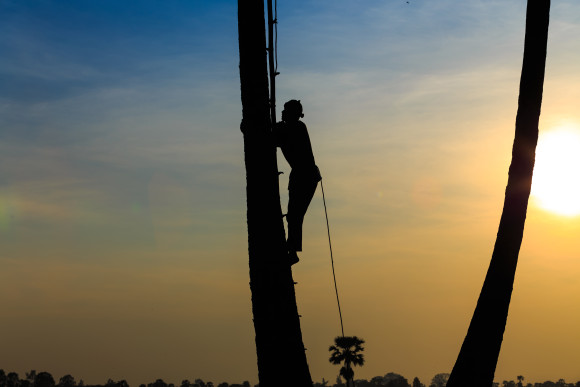There may be nothing more synonymous with Los Angeles County than the tall, waving palm trees that line so many busy boulevards and beach fronts.
Yet the towering icons of Southern California have a dark side. Palm trees have been a deadly trap for numerous unfortunate workers over the years, and now one public health official and an association are trying to get the word out and save some lives.
It was less than two months ago when Robert Harrison, MD, a professor of medicine at UC San Francisco and chief of the Occupational Health Surveillance and Evaluation program at the California Department of Public Health, came to the conclusion that more effort should go into warning people about the dangers posed by palm trees.
In mid-August rescue workers found Angel Ferreira-Zamora, a 41-year-old tree trimmer from Oak View, Calif., after he was reported being trapped in a palm tree. But it was too late.
Ventura County Medical Examiner’s office found that debris from the tree fell on Ferreira-Zamora and compressed him. He was still in a harness when found, and he had not fallen, authorities said. Compression asphyxia is the listed cause of death.
“Palm fronds are a silent hazard,” said Harrison, who issued a warning to everyone involved in the business via a blog on the Centers for Disease Control and Prevention website late last month.
Palms are plentiful throughout the Western U.S., as well as in balmy locales like Florida. There’s a high concentration of them in Southern California, where a variety of palm trees have been planted for more than 100 years.
Some estimates put the number of palm trees in Los Angeles County alone at more than 100,000.
Someone has to trim all those trees for the safety of those below, for aesthetic appeal and to keep the street from being utterly blocked after a windstorm. Those who live in Los Angeles can attest to the number of palm fronds that cover streets and sidewalks after a strong blow.
A palm frond is relatively light, and by themselves are quite harmless. A palm tree has many layers of fronds. Enough, in fact, to build into a lot of deadly weight.
“As they get mature and the fronds naturally dry, they drop their foliage,” Harrison said. “They look deceptively benign.”
Several workers have been killed trimming palm fronds in L.A. County. The death of Ferreira-Zamora followed two years with no reported deaths in the county.
In 2012 three fatalities were reported in the county, according to The California Fatality Assessment and Control Evaluation, a program in the Occupational Health Branch designed to identify and study fatal occupational injuries. The California FACE program is funded by the National Institute for Occupational Safety and Health.
Beside Ferreira, workers killed in palm trimming incidents in the U.S. this year so far include Miguel Martinez, who was killed in Riverside, Calif., on July 30, and Michael J. Szymanski, who was killed in Atlantic Beach, Fla., on July 24, according to statistics through mid-August from the Occupational Safety & Health Administration. Additionally, dozens of other tree trimmer deaths were listed this year, OSHA stats show.
Another man who has been working to get the message out about the dangers palm trees pose to trimmers is Jose Mercado, founder of the Hispanic Arborist Association, an Azusa, Calif.-based group that provides safety information and education to Hispanic workers in the tree trimming and tree care industry.
Hispanics make up a large portion of the nation’s landscaping and tree trimming workforce, according to Mercado, who put together a palm tree safety video for tree trimming companies and their workers.
Mercado’s main message in the video is that these deaths are preventable with a little risk management.
He’s trying to promote a safer, though slightly more involved way, to trim palm trees that involve climbing up on the outside of the fronds and trimming the tree top down. The video his group created is being used by the FACE program to educate those in the tree trimming industry about the safer practices.
The biggest danger posed by a palm tree comes from rings upon rings of interlocked fronds that die off and fall down upon the rings below in a process called “sloughing.”
Perhaps a dozen to 30 fronds may occupy one ring, and there could be 15 to 20 feet of rings stacked on top of one another.
Each frond weighs only a few pounds, but together the entangled mess may amount to hundreds or thousands of pounds of dead fronds, Mercado said.
This isn’t much of a danger to workers trimming palm trees that line a street where a bucket truck can be brought in and safely raise a worker to the level of the fronds yet not beneath them. However, there are myriad hard-to-get-to places that require a worker to scale the tree to get to the fronds, Mercado said.
Traditionally a worker scales a palm tree using a lanyard affixed to the waist and climbing spikes, also called gaffs, attached to the shoes.
When a worker begins removing a lower layer, it could trigger an avalanche of palms.
Several bleak outcomes will likely result. A worker whose spiked shoes are dug firmly in to the trunk can get bent back to where his head meets his heels in a spine-shattering incident. Or the worker could get knocked to the ground, and suffer a severe injury or die from the fall.
Either scenario poses the danger of mechanical suffocation from the weight of the combined palms that can fall on a worker, crush his chest and render him unable to breathe.
In some cases the number of dead fronds in the tree ring are so numerous that when the rescue workers arrive they cannot immediately locate the injured worker.
“In one case they had to use thermal imaging,” Harrison said
Harrison said he had been noticing reports of deaths of palm tree trimmers for a while in states with a large number of palms, like Arizona and Nevada. But the latest death was enough for him to begin sounding the alarm.
“The fatality that occurred in Southern California was deja vu all over again,” Harrison said. “These deaths are preventable, there are clear cut ways to trim these fronds without having to get under them.”
Topics California
Was this article valuable?
Here are more articles you may enjoy.



 USAA to Lay Off 220 Employees
USAA to Lay Off 220 Employees  Uncertainty Keeps Prices Up; No Prior-Year Loss Development: Travelers
Uncertainty Keeps Prices Up; No Prior-Year Loss Development: Travelers  Cargo Owners in Baltimore Disaster Face ‘General Average’ Loss Sharing, MSC Says
Cargo Owners in Baltimore Disaster Face ‘General Average’ Loss Sharing, MSC Says  Undercover St. Louis Officer Beaten by Colleagues Awarded $23.5M
Undercover St. Louis Officer Beaten by Colleagues Awarded $23.5M 


